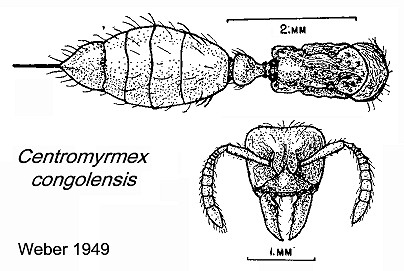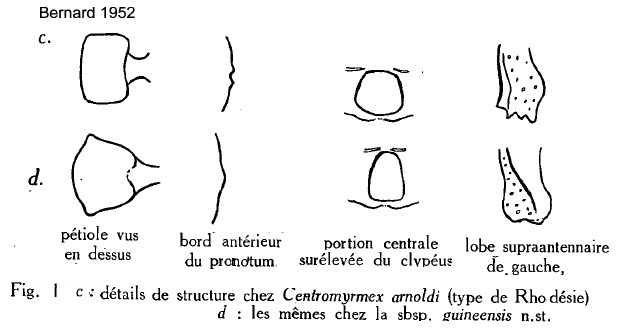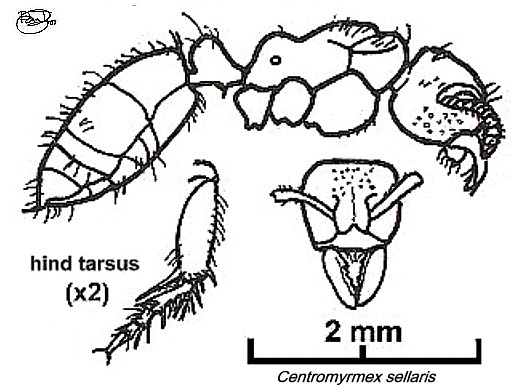Centromyrmex sellaris Mayr
  Type location Cameroun
(Mayr, 1896: 230, worker) collector Y. Sjöstedt - no type images on Antweb (November 2015) Type location Cameroun
(Mayr, 1896: 230, worker) collector Y. Sjöstedt - no type images on Antweb (November 2015)
Worker only
described (see Bolton, 1995)  . .
Former subspecies Centromyrmex
longiventris (Santschi, 1919b: 229, worker) from Victoria,
F. Silvestri, was given species status by me in October 2007.
Mayr's (1896) description is at  . Mayr compared this with Centromyrmex feae . Mayr compared this with Centromyrmex feae
|
Bolton & Fisher (2008: 22) gave the following
synonymies -
Centromyrmex constanciae Arnold, 1915: 38, pl. 2,
Fig. 14; workers and queen; from Zimbabwe, Bembesi,
24.iii.1913, collector G Arnold; male described by Arnold (1926: 199) - see https://www.antweb.org/specimenImages.do?code=casent0902463.
Centromyrmex arnoldi Santschi, 1919: 229, figs a-d,
workers and male; from Mozambique, Amatongas Forest, ix.1917,
collector G. Arnold; changed to a variety of constanciae by
Santschi (1920: 8); synonymized with constanciae by Arnold
(1926: 199). Arnold also reported he had sent specimens to Forel and he
(Forel) was of the opinion that it was a synonym of C. sellaris. See https://www.antweb.org/specimenImages.do?code=casent0915169
Centromyrmex arnoldi r. guineensis Bernard,
1952: 186, fig 1d, holotype worker; from Guinea, Mt. Nimba,
Nion, St. 22, 700 m, 15.iv.1942, collector Lamotte - see https://www.antweb.org/specimenImages.do?code=casent0913728.
Bolton, B. & Fisher, B.L. 2008c. Afrotropical ants
of the ponerine genera Centromyrmex Mayr, Promyopias
Santschi gen. rev. and Feroponera gen. n., with a revised key
to genera of African Ponerinae (Hymenoptera: Formicidae). Zootaxa,
1929, 1-37 - weblink - http://www.mapress.com/zootaxa/2008/f/z01929p037f.pdf
[10 Nov. 2008]
Specimens shown on Antweb and listed as sellaris
CASENT9966705 - Lusaka, Zambia (Fig. 25-26 in Bolton, 2008)
SAM-ENT-11511 - Mozambique, Amatongas Forest - Centromyrmex arnoldi
of Santschi (1919: 229)
|

Centromyrmex constanciae Arnold; type
location Zimbabwe (Arnold, 1915: 38, illustrated, worker and
queen; Arnold, 1926: 199, male); subspecies nominal, plus angolensis
(Santschi, 1937d: 214, worker) from Angola and guineensis
(Bernard, 1952: 186, illustrated, worker) from Guinea, Mt.
Nimba ; all forms described (see Bolton, 1995).
Arnold's (1915) illustrated description of constanciae
is at  and and  . .
|
 Santschi's (1919b) description of arnoldi is at Santschi's (1919b) description of arnoldi is at  . Santschi's (1920b) note is at . Santschi's (1920b) note is at  . Arnold's (1926: 199) translation and
re-description is at . Arnold's (1926: 199) translation and
re-description is at  . .
|
![{Centromyrmex sellaris]](centromyrmex_sellaris_cotype_SAM_ENT_0011511A.jpg) The
photomontage is collated from http://www.antweb.org/specimen.do?name=SAM-ENT-0011511A.
Mocambique: Amatongas Forest (coords for Amatongas); 19°11'00"S
033°45'00"E Collection Information Collection codes: SAM-ENT-0011511
Date: 15 Feb 1917 Collected by: G.Arnold. The
photomontage is collated from http://www.antweb.org/specimen.do?name=SAM-ENT-0011511A.
Mocambique: Amatongas Forest (coords for Amatongas); 19°11'00"S
033°45'00"E Collection Information Collection codes: SAM-ENT-0011511
Date: 15 Feb 1917 Collected by: G.Arnold.
The Centromyrmex arnoldi of Santschi (1919:
229), noted as a variety of constanciae by Santschi (1920: 8).
Synonymised with constanciae by Arnold (1926: 199).
|

Centromyrmex congolensis Weber; type
location Zaïre (Weber, 1949b: 5, illustrated, worker); worker
only described (see Bolton, 1995).
Weber's description (1949b, updated by me) is -
WORKER: Extended length 6.3 mm; of thorax 1.8 mm. Head in front view
squarish, excluding mandibles one and one-sixth times broader than
long, occipital margin truncate, feebly concave, corners rounded
anteriorly, anterior clypeal margin produced in a broad, truncate lobe;
frontal lobes short, feebly convex; eyeless; mandibles falcate, outer
margin broadly convex, cutting margin about twice as long as inner
basal margin and with about 10 feeble and irregularly spaced denticles,
apex in the form of an acute tooth; antennal scapes long and slender,
slightly exceeding the occipital corners, gradually enlarged and bowed
distally, first funicular segment longer than the following two
segments taken together, following segments gradually thickening and
lengthening to an indistinctly four- or five-segmented club, terminal
segment equal in length to the three preceding ones taken together.
Thorax from above with evenly convex pronotal margin, the pronotum
being transversely crescent shaped, promesonotal suture marked and
impressed, metanotal region broadly and smoothly impressed, the lateral
impressions rising obliquely forward to meet at an angle, thus
isolating the propodeum as a rounded node; thorax in side view with
pronotum rising sharply to form a slightly obtuse angle, mesonotum
rising sharply above the pronotum and smoothly sloping into the
metanotal impression, the latter broad and saddle shaped, propodeum in
the form of a large, convex tubercle. Petiole from above with narrow,
distinct peduncle and large node which is broader than long, broader
behind than in front and with truncate posterior margin; in side view
with node evenly convex above and ventral surface with a short, acute
spine forwardly directed. Gaster elongate-ovate with sharply truncate
anterior margin and convex anterior angles; five segments exposed
dorsally, of which the fifth is more constricted from the preceding
than any others; sting long and exserted. Legs short and stout, the
coxae strongly incrassate, the femora less so, middle tibia covered
with sharp spines, the others with far fewer and more slender spines,
tarsi spinose.
Shining; head finely striate-punctate, the frons largely smooth except
for piligerous punctations, thorax with similar piligerous punctations,
and irregularly striate, gaster and appendages smooth except for the
same piligerous punctations. Pilosity of yellow, upright hairs of
variable lengths, clypeus with two long, fine hairs projecting over the
mandibles, inner surface of mandibles below the denticles with shorter
hairs, entire surface generally with scattered hairs; pubescence
confined to the legs distally and the funiculi. Brownish yellow,
appendages slightly darker.
HOLOTYPE: One worker taken March 1, 1948, at Niangara, Belgian Congo.
It was just beneath the soil surface under a thin cover of dead leaves
of mango and oil palm. The ant seemed completely helpless when exposed
to the daylight and writhed about when placed on the ground or in my
palm. It made no attempt to run away, curling and uncurling without
stinging, though it had a long, stout sting. Obviously its habitat was
exclusively hypogaeic, as the lack of eyes also indicates. This
remarkable ant has its middle tibia much more spinose than the fore and
hind tibia, while the fore tibia is much more massive and differently
proportioned compared with the others. It is possible that these
structures, together with the generally stout legs, including large,
globose coxae, protect the legs from being severed at any point by the
strong mandibles of soldier termites. They are adapted for locomotion
through the tenuous galleries of termites, where the ants may encounter
their prey. The pair of hairs on the anterior clypeal margin and the
short, stout hairs below the denticles on the mandibles must serve a
sensory purpose to inform the ant when it has moving prey to seize. The
scattered hairs over the entire surface are also doubtless sensory in
lieu of eyes.
From C. constanciae Arnold of Rhodesia the present species
differs distinctly in larger size, in less angular thorax and
propodeum, and in other ways. It appears to differ from C. sellaris
Mayr of the Cameroons in larger size (C. sellaris is given as
5.3 mm, and Santschi remarks that his specimens are still smaller) and
in other ways though comparison is difficult because Mayr's description
consists primarily of a comparison with an Indo-Malayan species, C.
feae Emery.
|
 Bernard's (1952) description of guineensis is at
Bernard's (1952) description of guineensis is at  . .
A subterranean ant usually found with termites, either
in or under rotten logs, sometimes in outer galleries of termite
mounds. The tarsal spines give traction on the walls of underground
tunnels and are a good example of special structural modifications.
According to Lévieux (1976a, 1983b), from Ivory Coast, at
Lamto, the colony size is around 400 adults and the main food is
termites.
Belshaw & Bolton (1994b) mention, without naming
species, that the Centromyrmex found in Ghana are
obligatory termitolestic.
|
 Nigeria
specimens (Taylor, 1976: 190). WORKER - TL 5.32, HL 1.06, HW 0.93, SL
0.68, PW 0.78 Nigeria
specimens (Taylor, 1976: 190). WORKER - TL 5.32, HL 1.06, HW 0.93, SL
0.68, PW 0.78
Colour golden-brown, shiny with sparse erect hairs. Head coarsely
punctate. Mandibles strongly down-curved. Eyes absent. Pronotum and
mesonotum flat dorsally, pronotum strongly marginated anteriorly and
laterally. Metanotal groove absent, propodeum pinched in and concave
dorsally at midlength, posteriorly convex with almost vertical
declivitous face. Coxae large, especially of anterior legs. Tarsi of
all legs with numerous down-curved spines and stiff hairs. Apical
tibial spurs of midlegs both small and simple. Hind tibiae with one
large pectinate and one simple spur.
Found at the Cocoa Research Institute of Nigeria, Idi
Ayunre, by me. Specimen listed by Bolton & Fisher (2008) but
without reference to Taylor (1976).
|
![{Centromyrmex sellaris]](centromyrmex_sellaris_casent0066705.jpg) The
photomontage is collated from http://www.antweb.org/specimen.do?name=casent0066705.
Collection Information: CASENT0066705; Locality: Zambia (N. Rhodesia):
Central: Lusaka, Leopard Hill, Kapuka Farm; 12°33'17"S 030°17'44"E 1300
m; Collection codes: BLF13551; Collected by: B.L.Fisher et al.;
Habitat: miombo woodland; Date: 30 Nov 2005; Method: ex soil. The
photomontage is collated from http://www.antweb.org/specimen.do?name=casent0066705.
Collection Information: CASENT0066705; Locality: Zambia (N. Rhodesia):
Central: Lusaka, Leopard Hill, Kapuka Farm; 12°33'17"S 030°17'44"E 1300
m; Collection codes: BLF13551; Collected by: B.L.Fisher et al.;
Habitat: miombo woodland; Date: 30 Nov 2005; Method: ex soil.
This is the specimen shown by Bolton & Fisher (2008,
Figs 25-26). However, note the scape on this specimen appears not to
surpass the occiput, unlike on all the others shown above. The petiole
also is not parallel sided
|
|